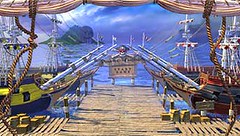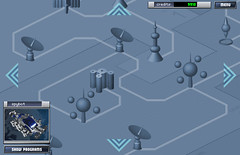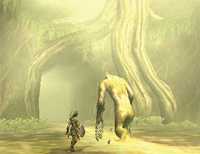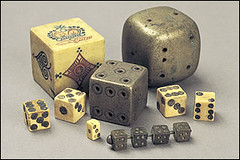Descent to the Underworld
 Students at nine universities from four nations used Internet2 to collaborate on Descent to the Underworld, an educational videogame that teaches players about "myth and mythical narrative."
Students at nine universities from four nations used Internet2 to collaborate on Descent to the Underworld, an educational videogame that teaches players about "myth and mythical narrative."
Fueled by New Mexico State University's Learning Games Initiative and Learning Games Lab, this blog will chronicle issues we deal with in creating educational games. We'll be posting responses to research we've done or read, musing on challenges we've faced in creating games, and pondering activities to help new game developers learn. The Learning Games Initiative and Lab is run by Barbara Chamberlin, Ph.D. and administered by Agricultural Communications.
 Students at nine universities from four nations used Internet2 to collaborate on Descent to the Underworld, an educational videogame that teaches players about "myth and mythical narrative."
Students at nine universities from four nations used Internet2 to collaborate on Descent to the Underworld, an educational videogame that teaches players about "myth and mythical narrative."
This gamers' manifesto is mainly aimed at console games, but there are a few tidbits in there that speak to game design for educational games, too, such as the "Save anytime, anywhere" thing. It's always good to take a step back and question the things we take as axiomatic in games, and see if we can break them - it will either make our axioms stronger, or help us divest ourselves of limitation. Either way, it's a win.
 Well, Disney's multiplayer virtual theme park, Disney's Virtual Magic Kingdom, is now in public beta, and it was made in Macromedia Director (not Flash), which means this sort of application is within reach of smaller development shops, with a little effort. In fact, it was made by the fine folks over at Sulake, makers of the popular Habbo Hotel virtual community.
Well, Disney's multiplayer virtual theme park, Disney's Virtual Magic Kingdom, is now in public beta, and it was made in Macromedia Director (not Flash), which means this sort of application is within reach of smaller development shops, with a little effort. In fact, it was made by the fine folks over at Sulake, makers of the popular Habbo Hotel virtual community.
 Over on the Lego site, there's a tactical combat game called Spybotics: The Nightfall Incident that is surprisingly deep from both a gameplay and a story perspective, and also very polished.
Over on the Lego site, there's a tactical combat game called Spybotics: The Nightfall Incident that is surprisingly deep from both a gameplay and a story perspective, and also very polished.
I love puzzle games and just saw this over at Wired.com. There is a craze for these su doku puzzles over in the UK that has jumpstarted newspaper purchasing. I need a good puzzle.
The Guardian Unlimited Gamesblog has an editorial on how the game industry is shying away from developing new IP in the waning seasons of the current generation of consoles. In particular, it says that "there are no new games going into development for PS2 and Xbox, it’s all sequels and branded tie-ins from now on." The author takes the position that this is a bad thing, asserting that:
Relying solely on sequels is the videogame equivalent of incest – eventually, the gene pool goes stagnant.
We are seeing many magnet programs and charter schools redefining public education. How does this group feel about such an intensive technology program such as this, rather than a broader based approach to learning? Our lab will allow us to study the technology kids are using in a concentrated short amount of time. Are these schools something we should be looking at for studies and or structure as we began to shape our lab and efforts?
 Nintendo has announced yet another repackaging of the Game Boy Advance handheld console, this one called the Game Boy Micro. It's got a stylish silver case, and it's tiny - 4 inches by 2 inches, weighing about the same as "80 paper clips."
Nintendo has announced yet another repackaging of the Game Boy Advance handheld console, this one called the Game Boy Micro. It's got a stylish silver case, and it's tiny - 4 inches by 2 inches, weighing about the same as "80 paper clips."
 GameSpot has posted some The Legend of Zelda: Twilight Princess screenshots. I was particularly impressed by the art direction - the detail in these screenshots is impressive, but the staging and the mood effects are pretty compelling, too. (If you look closely, you'll see different environmental effects, such as the "floating crap in the air" a'la Legend in the more serene places, pinned yellow glows in forest glades, and dirt tromped up by horses and war pigs in the mounted battle scene.)
GameSpot has posted some The Legend of Zelda: Twilight Princess screenshots. I was particularly impressed by the art direction - the detail in these screenshots is impressive, but the staging and the mood effects are pretty compelling, too. (If you look closely, you'll see different environmental effects, such as the "floating crap in the air" a'la Legend in the more serene places, pinned yellow glows in forest glades, and dirt tromped up by horses and war pigs in the mounted battle scene.)There's an article over on BBC News about why good ideas beat good graphics in game design, with thoughts on the matter from Nintendo president Satoru Iwata, world-class game designer Peter Molyneux, and others.
There is a big push for the "Infusion" of integrating thinking skills into the regular curriculum. Why is it that most teachers fail to see the value video games bring to students? I see it as creative thinking in which one is building on fluency, flexibility, originality and elaboration. Creative thinking skills are very much related to critical thinking skills, which these students should acquire.
BlitzMax is a new cross-platform (Win, Mac, Linux) rapid game development product. It's cheap at $80, has a faster engine (ostensibly) than Director's sprite engine, and has native access to OpenGL programming for 3D work.
This is a bit of fun. Student Survivor is a marketing tool to help raise the profile of UNIAID, a charitable
It looks like the next console generations from Sony and Microsoft are including as a key feature the ability to kill you two ways: by having the monster bash you until you run out of hit points, or to kill you - the player - by nickel and dime-ing you to death. That's right - microtransactions built right into your game console! Hey, for just ninety-nine cents, you can upgrade your sword. Oh, for another ninety-nine, you can beef up your armor. Oh, that boss monster still to tough for you? Perhaps you'd be interested in a couple of healing potions - only fifty cents a pop.
When the game becomes nothing more than a tool to drive more money to the shareholders, it's quickly able to shed all vestiges of a game.He correctly points out that there is great temptation now for the executive producers to demand games that are little more than vehicles to prompt people to buy in-game content - and indeed, to hold back the best content for the highest-paying customers.
Even a man who is pure of heart and says his prayers by night may become a wolf when the wolfbane blooms and the moon is full and bright.Apparently, there is a class of social games which places a predator amidst a group of victims. Greg Aleknevicus has an interesting article on Werewolf, a particular variety of the game.
A new conference called the Casual Games Conference has cropped up to support the burgeoning casual games industry. This is a ripe segment that our media program could handsomely target, since we're not targeting the big game media market.
Ian Bogost of Water Cooler Games blogged earlier this week about Armchair Games, a set of extremely simple games used as an advertising tool for a big screen television. (Example... use your left and right keys to make a guy run to the bathroom... ready, go... 8 seconds... new record!... email us your information and we'll put you in the running to win the prize).
In the latest issue of the Games Journal, there is an interview with Mike Doyle, an artist who does box art and component design for board games. While much of the article is specifically targeted at board games, there are some things that I think have relevance to the world of educational gaming as well. In particular, he talks about shedding the "stigma" that board games suffer under. Since educational games suffer under a similar stigma, it's worth a read.
"The world of games desperately needs to become relevant and desirable within our culture... With all the exciting facets these new games have to offer, publishers should be holding the keys to a lifestyle that people want to be part of."
There are several instances of Dance Dance Revolution (DDR) games being used in after school programs, gym classes, etc to help stem the obesity epidemic among our youth. In talking with other another parent (also a nutrition Extension educator), we wondered if we can use a DDR videogame to change the culture in schools of using food as a fundraiser. In many schools, vending machines provide valuable revenue for PTAs and other groups, making schools reluctant to remove them. Additionally, many schools have school fundraisers centered around food: bake sales, candy sales, etc. We wondered if we couldn't create a pilot project where fundraising centered around activity: bouncy castles and slides at recess, DDR video games in the halls, pedometer sales, etc. If we were to go back 20 years to when I was in school, I can't imagine a school allowing any arcade game into the hallways... are games finally reaching a status level where they will be allowed in educational institutions?
 Check out these awesome 3D learning gizmos by ForgeFX. Done in Shockwave3D, they are great examples of what the 3D capabilities of Director are. (Note for users of Safari: there's a bug that shifts the shockwave3D content up about 30 pixels, so you'll have to aim low with your mouse to interact with the gizmos.)
Check out these awesome 3D learning gizmos by ForgeFX. Done in Shockwave3D, they are great examples of what the 3D capabilities of Director are. (Note for users of Safari: there's a bug that shifts the shockwave3D content up about 30 pixels, so you'll have to aim low with your mouse to interact with the gizmos.)
Since we're talking about Katamari Damacy, you might want to check out this synopsis of Keita Takahashi's speech at the Game Developer's Conference. (Keita Takahashi is the person who came up with Katamari Damacy.)
Keri Facer, head of Learning Research at NESTA Future Lab, does a nice job reviewing some personal thoughts and research on games and learning. The review (found at http://www.nestafuturelab.org/research/discuss/02discuss01.htm) does a nice job of introducing some of the major names in the field, Malone, Prensky, Csikszentmihalyi (Pronounced chick-sent-me-high-ee), as well as some of the issues for research (classification, motivation, learning). It is a good read if you haven't done much research in games area.
 NPR has a story on the Ancient Origins of Modern Board Games, or rather an exhibit on the topic currently on display at the Smithsonian, entitled Asian Games: The Art of Contest. Apparently, abstract games like Parcheesi and juvenile games like Chutes and Ladders came from much earlier Asian versions of games that held more than simple entertainment value. (Indeed, they even performed the role of guides to spiritual and bureaucratic success.)
NPR has a story on the Ancient Origins of Modern Board Games, or rather an exhibit on the topic currently on display at the Smithsonian, entitled Asian Games: The Art of Contest. Apparently, abstract games like Parcheesi and juvenile games like Chutes and Ladders came from much earlier Asian versions of games that held more than simple entertainment value. (Indeed, they even performed the role of guides to spiritual and bureaucratic success.)
John Paul Bichard (better known on the Director lists as "Gerbil" and/or "Psychic Parrot") has been a little scarce in the Director scene lately. Now we know why. He's been working on Backseat Playground, a mobile gaming project which attempts to connect kids riding in the back seats of cars with the environments they travel through using an innovative game design. The hope is that it prompts kids to take an interest in geography and local history.
SiSSYFiGHT 2000 is a very simple, and yet oh-so-very-complex, multiplayer game which has incredibly simple rules, but which pulls those rules into a social context for much richer, much deeper, and much more interesting gameplay. This Shockwave-based gem has been around for years, but it apparently still has a strong following.
There's a review of new features for the next incarnation of Flash (codenamed "8Ball") over at oman3d.